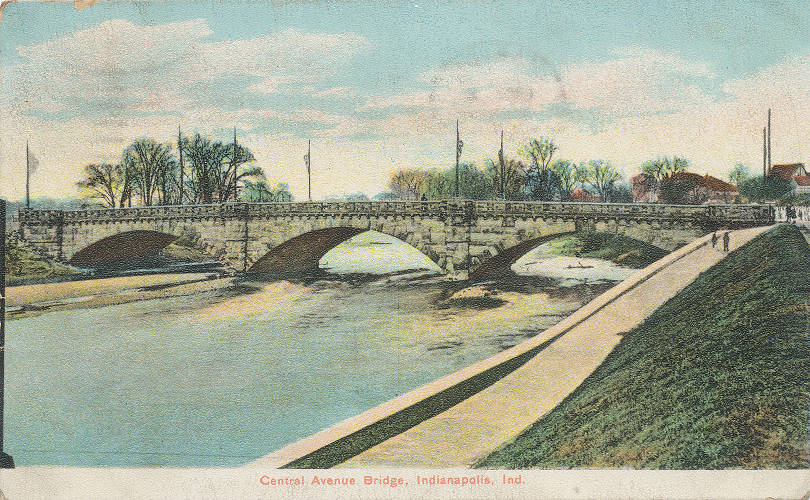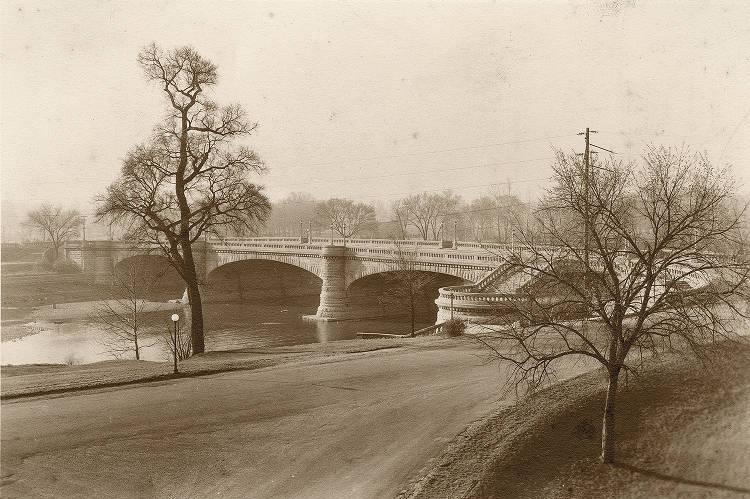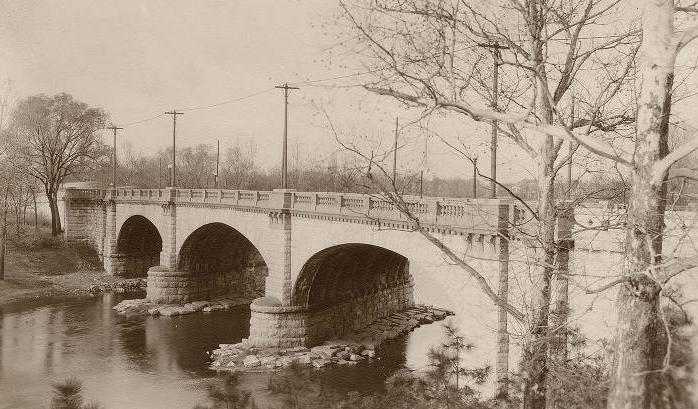In 1899, a program of replacing Indianapolis’ steel and iron bridges with new “permanent” stone and concrete ones began. The first bridges to be replaced were on Fall Creek at Meridian and Illinois streets. The new bridges were designed by Henry W. Klaussman and constructed of stone-faced concrete with melan arches (rigid truss arches made of iron invented by Austrian engineer Josef Melan) for support beneath the roadway.

That same year, the city added a third new bridge, built of stone, at Central Avenue. In 1905, the city erected the College Avenue bridge, a stacked stone construction that resembled a bridge in Scotland. It was considered an engineering marvel because its piers were set at an angle from the bridge, placing them in line with the flow of the creek rather than the roadway above.
The 30th Street bridge spanned Fall Creek in 1906. According to legend, the two stone mermaids on its center buttresses were once young women trying to escape the smoke and noise of downtown Indianapolis by moving north. When they reached 30th Street they looked back at the city and were turned to stone. In 1911, a new bridge went up at Capitol Avenue and Fall Creek. It had massive supports and was decorated with concrete cascading flowers. Landscape architect called these beautiful new bridges, also designed by Henry Klaussman, one of Indianapolis’ greatest assets. Unfortunately, in 1913 both the Meridian Street and Illinois Street bridges were heavily damaged by the city’s worst flood.

By 1917, however, the city had rebuilt the bridges in an even more ornate fashion. The new Meridian Street bridge was fashioned after the Victor Emmanuel span over the Tiber River in Rome. The concrete bridge featured decorative medallions, lamps on the balustrades, and flower boxes at each end. The new Illinois Street bridge was less ornate, but also of massive design.
The Central Avenue Bridge, the College Avenue Bridge, and the Capitol Avenue and Illinois Street bridges underwent reconstruction in the late 2010s. The Capitol Avenue and Illinois Street bridges were the first to be repaired. The Central Avenue Bridge project closed for reconstruction in 2017. Its restoration, overseen by the state historic preservation officer, became the most involved. Some pieces of the bridge could not be salvaged because they were too worn or damaged. Replacement stones for its repair came from a vendor in Ohio. The Indianapolis Department of Public Works used 1,700 of the original stones, and 800 new stones were added to complete its historic restoration. The bridge reopened for traffic in July 2019. Project costs totaled $5.5 million. The College Avenue bridge closed for 60 days for reconstruction in fall 2018, with a total cost of $7.6 million.

Although the Fall Creek bridges are architecturally important, they have an even deeper significance to the city of Indianapolis. Each new bridge, from Fall Creek Boulevard to 56th Street, heralded the city’s progress northward. Development followed the construction of the new bridges. After 1917 Indianapolis’ elite, and increasingly its middle class, moved out of the downtown area and migrated ever northward across the Fall Creek bridges.
The five bridges are listed on the National Register of Historic Places.

Help improve this entry
Contribute information, offer corrections, suggest images.
You can also recommend new entries related to this topic.